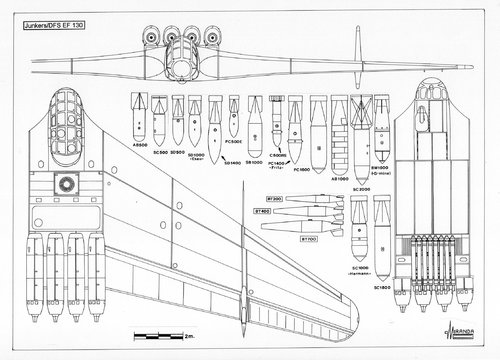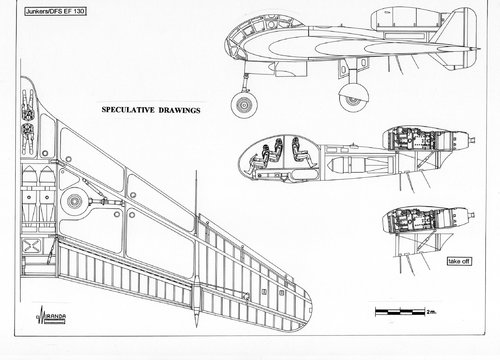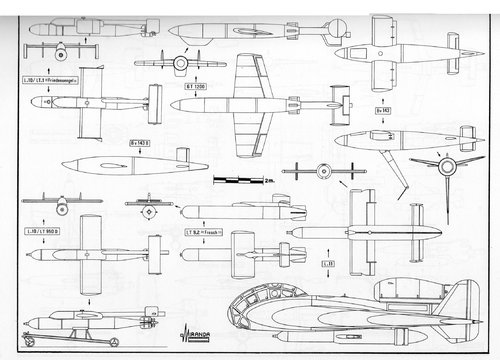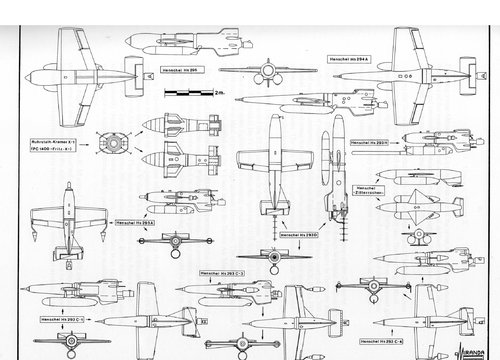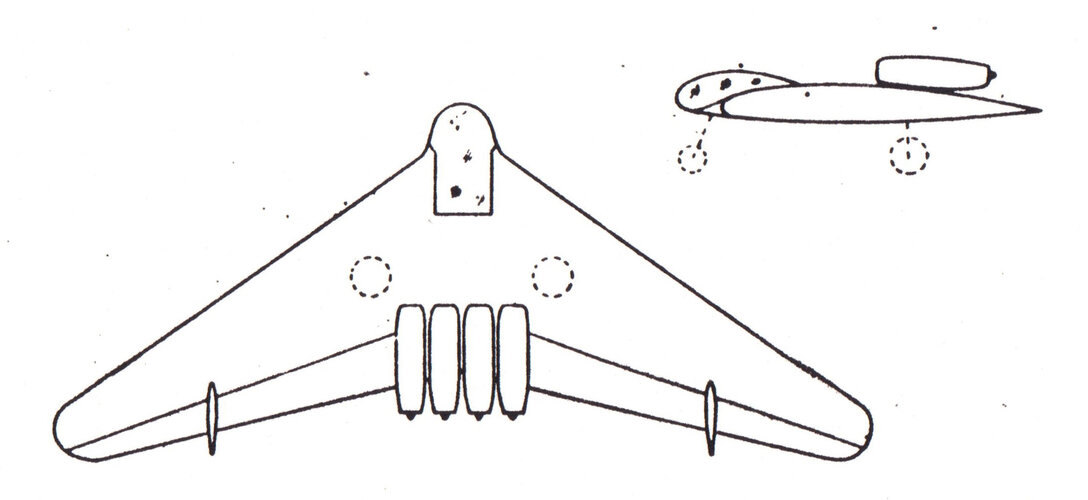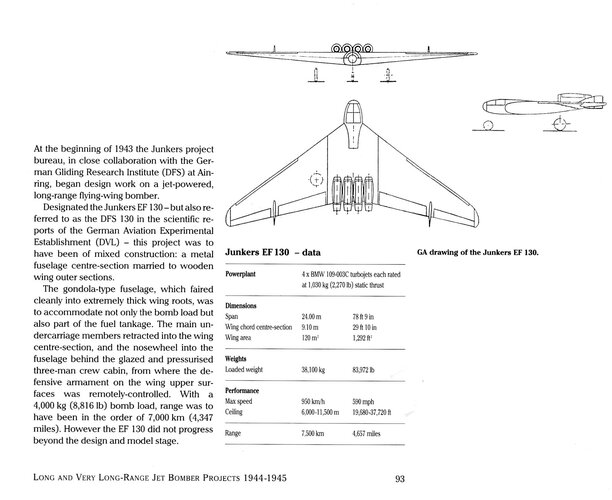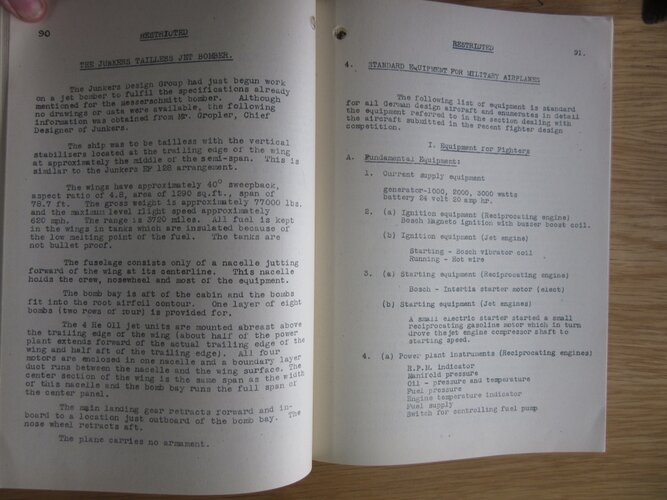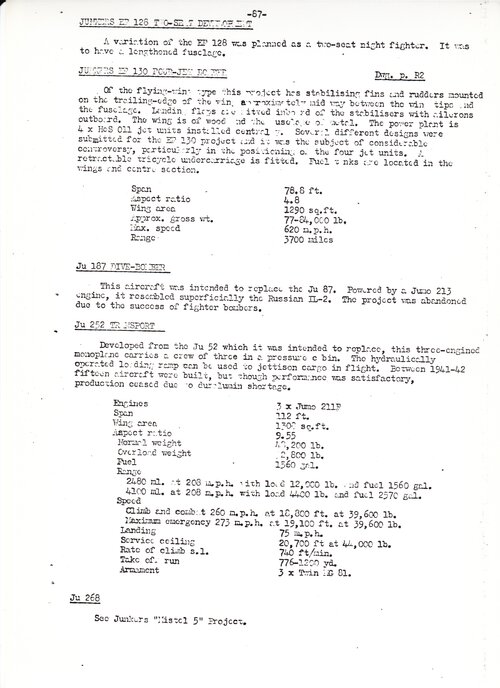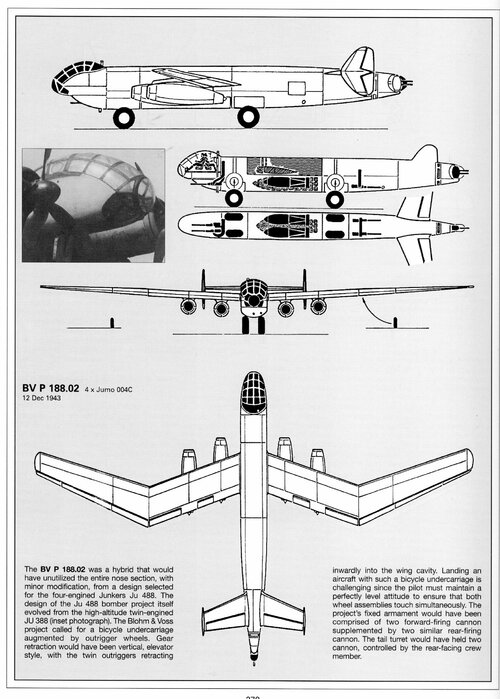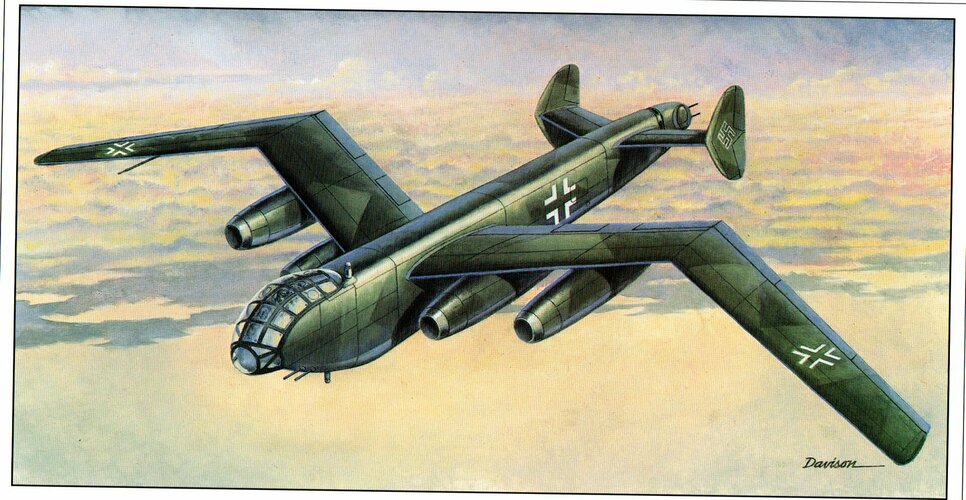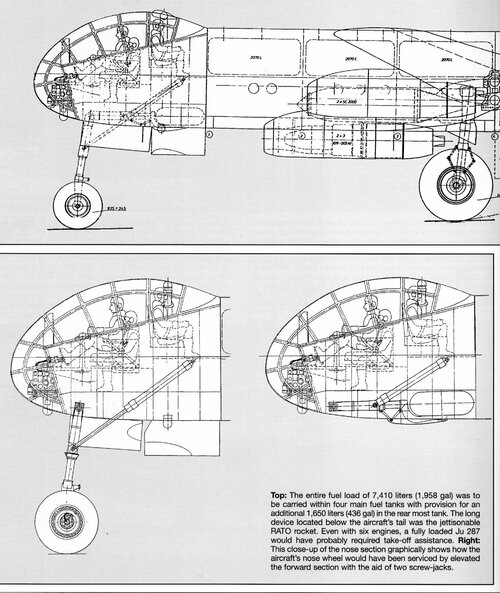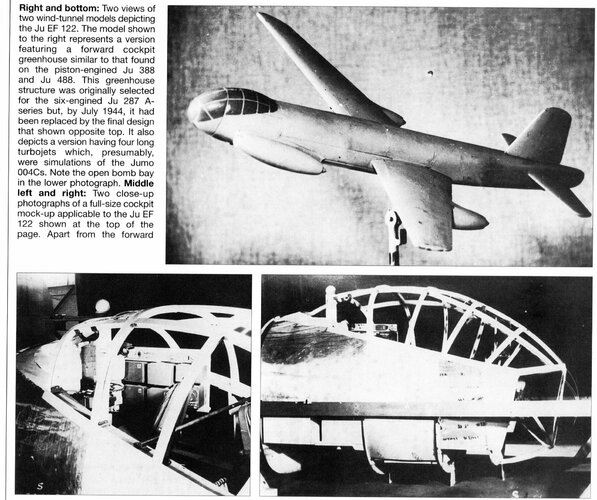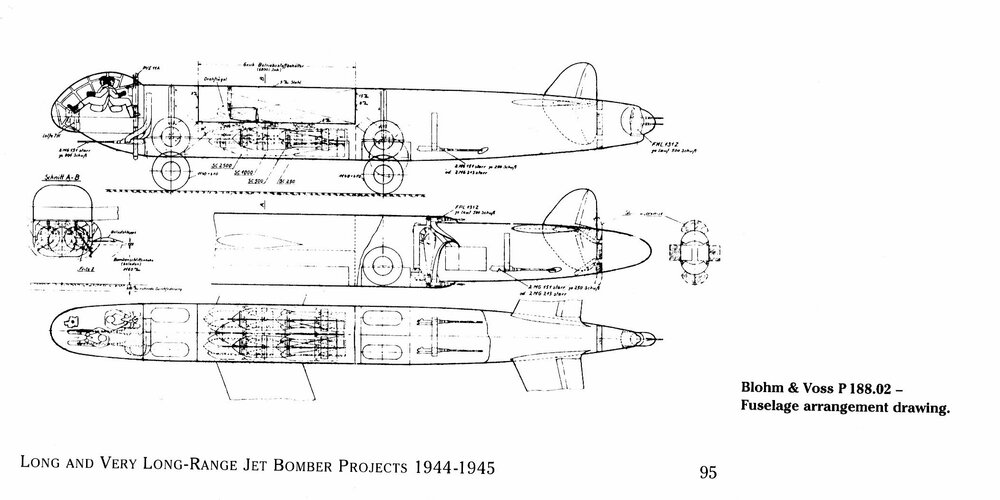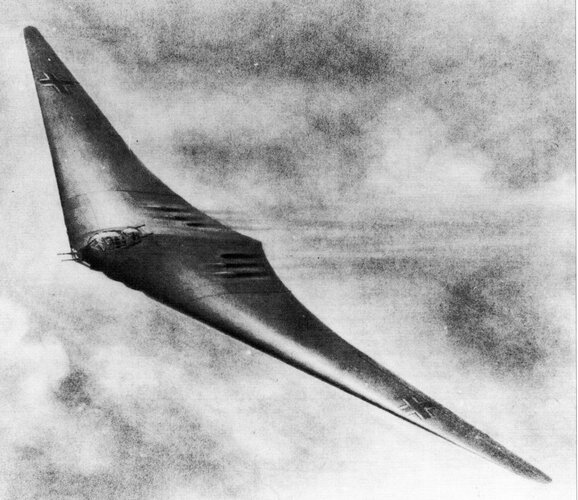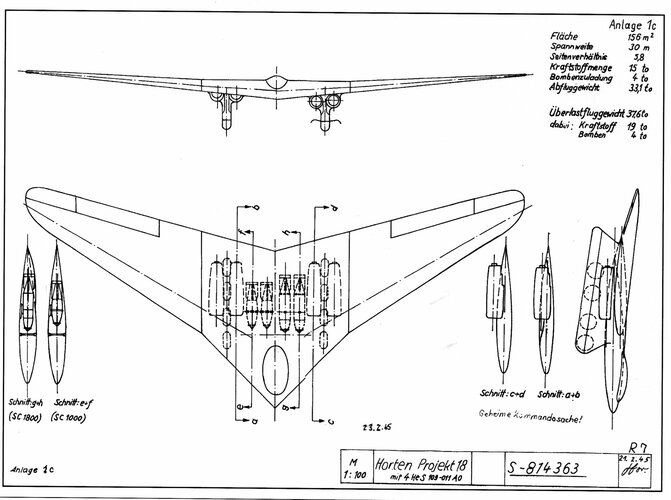All we have to go on for the EF 130 is two different text descriptions and a single postwar drawing.
- Junkers / DFS EF-130
A four engine heavy bomber of ‘Uralbomber’ class designed in the autumn of 1944 to compete against the Arado E-555, the BMW ‘Strahlbomber Projekt II’, the Horten Projekt 18 (23/2/1945) and the Messerschmitt P.1108.
It had a pressurised cockpit for a crew of three, originally designed for the Junkers Ju 388, and the undercarriage of a Junkers EF-131. The wing was a DFS design with leading edge slats, flaps and ailerons.
The system used to power the rotation manoeuvre during takeoff was unknown. It may be speculated that the engines could swing with the help of some hydraulic mechanism to change the thrust direction. That would explain the odd position they are located, in the aerodynamic shadow generated by the cockpit.
The project did not pass the wind tunnel model phase, being cancelled in March 1945.
This description is, I think, entirely inaccurate.
There was a competition between Messerschmitt (P 1107), the Horten brothers (H XVIII) and Junkers (Ju 287) in January-February 1945 to create a 'Langstreckenbomber' capable of attacking Allied air bases in the UK. It was thought that a jet bomber would be largely unassailable by interceptors and could destroy the RAF and US bomber fleets on the ground - buying Germany a valuable respite from the constant bombing (although clearly by this point the bombing campaign was practically over. According to a Heinkel memo dated January 27, 1945, Hitler ordered at this time that the design of a jet bomber should be 'forced').
The Arado E 555 (worked on continuously from July 1943 to February 1944, then seemingly abandoned for eight months before a summary report was issued on October 18, 1944) was conceptual in nature, as were BMW's Strahlbomber designs. It is at least possible that the Langstreckenbomber competition came about as a result of designs such as these being shown to senior personnel, but neither design was a 'competitor'.
The winner of the Langstreckenbomber competition was Junkers - because the Ju 287 could be put into service the fastest. But the Hortens' H XVIII had proven very interesting to the competition adjudicators because it had been calculated that a flying wing bomber could carry a lot of fuel and bombs while maintaining a decent speed and altitude. The fixed undercarriage of the H XVIII, which would have resulted in unacceptable tyre wear when turning on the ground(!) and increase drag in the air, was what let it down.
Messerschmitt therefore was apparently therefore commissioned to work on a flying wing version of the P 1107 - the P 1108 - with retractable undercarriage. But according to CIOS report XXXI-3 German High Speed Airplanes and Design Development of August 1945 by Robert W. Kluge and Charles L. Fay of the US Technical Industrial Intelligence Committee, page 89, "early in 1945 the Government decided that Messerschmitt did not have sufficient engineering manpower to handle the bomber design and turned it over to Junkers and the Horten Bros."
So Messerschmitt ceased work on the P 1108 and the flying wing project was taken on by Junkers with the Horten brothers acting as consultants.
The same report continues on p90:
"The Junkers Design Group had just [before the war ended] begun work on a jet bomber to fulfil the specifications already mentioned for the Messerschmitt bomber. Although no drawings or data were available, the following information was obtained from Mr. Gropler, Chief Designer of Junkers.
The ship was to be tailless with the vertical stabilizers located at the trailing edge of the wing at approximately the middle of the semi-span. This is similar to the Junkers EF 128 arrangement.
The wings have approximately 40-degrees sweepback, aspect ratio of 4.8, area of 1290 sq ft, span of 78.7ft. The gross weight is approximately 77000 lbs. and the maximum level flight speed approximately 620mph. The range is 3730 miles. All fuel is kept in the wings in tanks which are insulated because of the low melting point of the fuel. The tanks are not bullet proof.
The fuselage consists only of a nacelle jutting forward of the wing at its centerline. This nacelle holds the crew, nosewheel and most of the equipment.
The bomb bay is aft of the cabin and the bombs fit into the root airfoil contour. One layer of eight bombs (two rows of four) is provided for.
The 4 He 011 jet units are mounted abreast above the trailing edge of the wing (about half of the power plant extends forward of the actual trailing edge of the wing and half aft of the trailing edge). All four motors are enclosed in one nacelle and a boundary layer duct runs between the nacelle and the wing surface. The center section of the wing is the same span as the width of this nacelle and the bomb bay runs the full span of the center panel.
The main landing gear retracts forward and inboard to a location just outboard of the bomb bay. The nose wheel retracts aft.
The plane carries no armament."
There is no mention here of the number of crew, a Ju 388 cockpit, the undercarriage of an EF 131 (a project which wasn't started until after the war), any DFS involvement, nor any mention of a hydraulic system for raising the engines. Similarly there is no evidence that this new project was cancelled. The war simply ended before it could go anywhere beyond a few brief notes.
The second text description comes from the famous British report of January 1946, German Aircraft: New and Projected Types by H. F. King. This says of the EF 130:
"Of the flying-wing type this project has stabilising fins and rudders mounted on the trailing-edge of the wing approximately mid way between the wing tips and the fuselage. Landing flaps are fitted inboard of the stabilisers with ailerons outboard. The wing is of wood and the fuselage of metal. The power plant is 4 x HeS 011 jet units installed centrally. Several different designs were submitted for the EF 130 project and it was the subject of considerable controversy, particularly in the positioning of the four jet units. A retractable tricycle undercarriage is fitted. Fuel tanks are located in the wings and centre section.
Span: 78.8ft, aspect ratio: 4.8, wing area 1290sq ft, gross weight 77-84,000lb, max. speed 620mph, range 3700 miles."
This description, again, makes no mention of the number of crew, a Ju 388 cockpit, the undercarriage of an EF 131, any DFS involvement, nor any mention of a hydraulic system for raising the engines.
It does provide a little detail about the materials intended to be used for the EF 130, provides an interesting albeit brief mention of disagreements concerning the design (perhaps between Gropler's personnel at Junkers and the notoriously single-minded Hortens), and slightly conflicts with the first account over the positioning of the fuel tanks.
A rough illustration of the EF 130 is included in the report and is the only known contemporary depiction of it to be found anywhere (see below). This illustration (which I presume provided the basis for Justo's drawings) is of precisely the same style as those found in a separate report on Junkers' final design work, which includes images of the EF 126 and EF 128. We actually know what both of those designs really looked like and the postwar sketches are poor facsimiles to say the least. Therefore, I would suggest that the text descriptions actually give a better idea of how the EF 130 was supposed to look than the drawing.
Beyond these two descriptions, and this one sketch, there is no further known contemporary evidence of how the EF 130 was intended to look.

